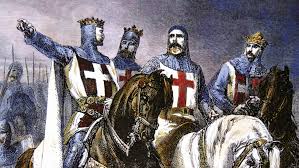The Crusades (1095–1300 CE) were a series of military campaigns launched by European Christian states to reclaim the Holy Land from Muslim rule. While their primary goal was religious and territorial conquest, the Crusades had an unintended yet profound economic impact on Europe, particularly in revitalizing gold circulation. As European armies traveled to the Middle East, they encountered the prosperous economies of the Byzantine Empire and the Islamic Caliphates, both of which were heavily reliant on gold-based monetary systems.
Through war, trade, and cultural exchange, the Crusades helped reopen old trade routes, introduced Europeans to Islamic gold coins like the dinar, and eventually led to the revival of gold coinage in medieval Europe.

The Crusader Economy: Gold as a Means of War and Wealth
Financing a Crusade required enormous amounts of wealth, which led European rulers to collect gold and silver through taxation, loans, and the sale of land. Some of the ways gold played a role in Crusader finances included:
- Papal Taxation & Crusader Tithes – The Catholic Church imposed special taxes to fund Crusades, collecting gold from across Europe.
- Loans from Italian Banking Families – Wealthy banking families in Venice, Genoa, and Florence provided gold-backed loans to kings and Crusader leaders.
- Treasure Plundering – After victories, Crusaders looted gold artifacts and coins from Byzantine, Muslim, and Jewish communities.
One of the most significant gold transfers occurred in 1204 CE, when the Fourth Crusade sacked Constantinople, plundering massive amounts of gold and wealth from the Byzantine capital.
The Role of Italian City-States in Gold Circulation
The Italian maritime republics—Venice, Genoa, and Pisa—played a crucial role in reintroducing gold coinage to Western Europe. These cities:
- Dominated Mediterranean trade, linking Europe with the Middle East and North Africa.
- Acted as financial hubs, where gold dinars and Byzantine solidi were exchanged for European silver.
- Minted their own gold coins, inspired by the wealth they encountered in the Islamic and Byzantine worlds.
By the late 13th century, Venice introduced the gold ducat (1284 CE) and Florence issued the gold florin (1252 CE)—two of the most important medieval European gold coins.
The Return of Gold Coinage in Europe
Before the Crusades, gold coins had nearly disappeared from Western Europe, as silver had been the dominant currency since Charlemagne’s reforms in the 8th century. However, the influx of gold from the Crusades helped bring gold coinage back into widespread use. Key developments included:
- Increased Trade with the Middle East and North Africa – More gold entered Europe as merchants exchanged European goods for spices, silk, and other luxury items.
- Adoption of Gold Coinage by European Kingdoms – Inspired by Italian city-states, kingdoms like France, England, and the Holy Roman Empire began minting their own gold coins.
- Rise of a Gold-Based Financial System – Banking institutions in Italy and the Low Countries started using gold for international trade and credit systems.
By 1300 CE, gold was once again a central part of European economies, setting the stage for the later Renaissance and global trade expansion.
Conclusion: The Crusades as a Catalyst for Gold Circulation
While the Crusades were primarily religious and military campaigns, their economic consequences were profound. By reopening trade routes, increasing contact with gold-based economies, and encouraging European rulers to reintroduce gold coinage, the Crusades helped bring gold back into Western European circulation. This transformation laid the foundation for the Medieval Gold Coinage Boom, which would continue into the 14th and 15th centuries.
